|
Just call me Captain
by Tony Green
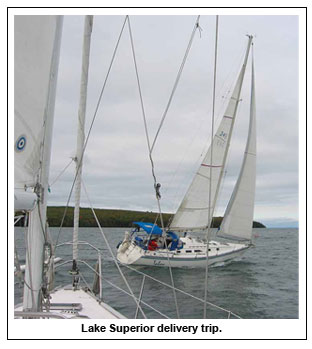 Afew years ago, I heard the call of
the sea again. I spent the first eight
years of my adult life in and around
nuclear submarines in Virginia and
Hawaii, and fell in love with the ocean.
I enjoyed many things about submarines,
but concluded that sailing on
top of the water was much more enjoyable
than being below the surface.
Among other things, sunsets observed
through a periscope were no match for
those experienced from the deck of a
small boat. As much as I enjoyed seaside
living, Midwestern roots and a
lovely St. Paul girl led me to Minnesota
in 1995. Kids and careers dominated
the next thirteen years. We owned a few
boats, sailed the city lakes in
Minneapolis, and chartered once a summer
on Lake Superior. Recently, I
dropped out of the rat race to stay home
with my daughters and decided to do
something fun before it was too late
(see “So You Want to Be a Sailing
Instructor?” Northern Breezes
Oct/Nov/Dec 2008). I began teaching
American Sailing Association (ASA)
Basic Keelboat classes for Northern
Breezes Sailing School in the summer
and Coastal Navigation and Marine
Weather in the winter, in addition to
working part time in the school office.
Afew years ago, I heard the call of
the sea again. I spent the first eight
years of my adult life in and around
nuclear submarines in Virginia and
Hawaii, and fell in love with the ocean.
I enjoyed many things about submarines,
but concluded that sailing on
top of the water was much more enjoyable
than being below the surface.
Among other things, sunsets observed
through a periscope were no match for
those experienced from the deck of a
small boat. As much as I enjoyed seaside
living, Midwestern roots and a
lovely St. Paul girl led me to Minnesota
in 1995. Kids and careers dominated
the next thirteen years. We owned a few
boats, sailed the city lakes in
Minneapolis, and chartered once a summer
on Lake Superior. Recently, I
dropped out of the rat race to stay home
with my daughters and decided to do
something fun before it was too late
(see “So You Want to Be a Sailing
Instructor?” Northern Breezes
Oct/Nov/Dec 2008). I began teaching
American Sailing Association (ASA)
Basic Keelboat classes for Northern
Breezes Sailing School in the summer
and Coastal Navigation and Marine
Weather in the winter, in addition to
working part time in the school office.
I enjoyed teaching and learning the
ropes of the sailing business. Family,
school and work kept us in Minneapolis
despite the short season. The sea was
calling, but there were always other priorities.
Lake Superior became a willing
surrogate for the salt water that I
craved. The open water, occasional
rough conditions and terrific cruising
only a few hours drive from home kept
me satisfied. As my interest, experience
and confidence in sailing instruction
grew, I knew it was time to move up the
ladder. In the ASA/Northern Breezes
hierarchy, that meant teaching Basic
Coastal Cruising and Bareboat
Chartering onboard the school’s liveaboard
yachts in Bayfield, Wisconsin.
But there was one major hurdle. To
teach on Lake Superior (or any of the
Great Lakes or oceans) you need to be
licensed by the U.S. Coast Guard.
Further motivation to advance was the
opportunity to break into the instructor
ranks for Northern Breezes’ classes in
the British Virgin Islands. I can think of
few better jobs than getting paid to sail
in the Caribbean in the winter. I was
determined to succeed and thought that
it couldn’t be that hard to get a license,
especially for an ex-Navy guy. I
researched the requirements, and
learned that it wouldn’t be as easy as I
thought. But I did it. Here’s how.
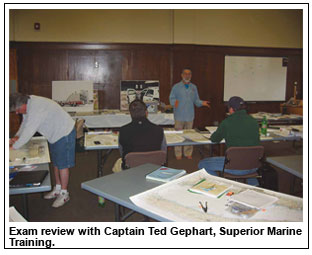 Let me publicly state here that my
wife, Kathleen, is a keeper. She was
amazingly supportive and knew how
much I loved teaching sailing, despite
the belief of many that it is a “play” job.
I also need to thank my daughters,
Danielle and Amy, who put up with an
absentee father for much of last summer
while I taught on the evenings and
weekends and logged hours in good
weather and bad.
Let me publicly state here that my
wife, Kathleen, is a keeper. She was
amazingly supportive and knew how
much I loved teaching sailing, despite
the belief of many that it is a “play” job.
I also need to thank my daughters,
Danielle and Amy, who put up with an
absentee father for much of last summer
while I taught on the evenings and
weekends and logged hours in good
weather and bad.
The first decision was what type of
Coast Guard license to get. The lowestlevel
license required to teach on the
Great Lakes is an Operator of
Uninspected Passenger Vessels
(OUPV), which restricts you to six paying
passengers and vessels smaller than
100 gross tons. This license is usually
referred to as a “Six-Pack,” a term I’m
told the Coast Guard dislikes. To carry
more than six passengers or to operate
inspected vessels (usually larger boats
like ferries, tugs and tour boats) you
need a Master’s license, which carry a
tonnage limit; typically 25, 50, 100 or
200 gross tons. Licenses are further
subdivided by geography, such as
Inland (lakes and rivers), Great Lakes
and Near Coastal waters (up to 100
nautical miles offshore). For any level
of license, I would need to submit the
following items (details can be found at
www.uscg.mil):
- Signed application (Coast Guard
form 719B)
- Conviction statement and written
disclosure of felonies and drug
arrests
- Three letters of recommendation
- Physical examination (Form 719K)
- Drug test (Form 719P)
- Documented CPR and First Aid
training
- Transportation Worker
Identification Credential (TWIC)
- Merchant Mariner Oath, signed
and notarized
- Pass a series of written examinations
- Evidence of appropriate sea service
(Form 719S)
- $145 Evaluation and Issuance Fee
(payable at www.pay.gov)
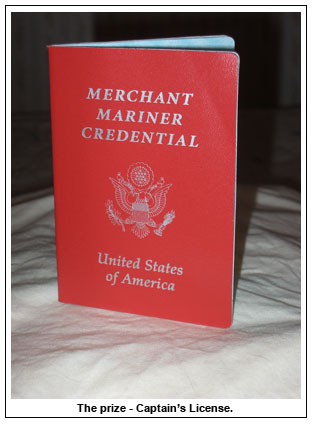 The list of requirements looked
daunting, although none were too difficult
taken individually. Like so many
tasks, it was just a matter of time and
money. What I wasn’t expecting was
that the most obvious prerequisite-boating
experience-would end up being the
bottleneck.
The list of requirements looked
daunting, although none were too difficult
taken individually. Like so many
tasks, it was just a matter of time and
money. What I wasn’t expecting was
that the most obvious prerequisite-boating
experience-would end up being the
bottleneck.
The minimum experience needed
for an OUPV (Six-Pack) or Master
Inland was 360 days on the water since
age 15, with 90 of those days in the past
three years. For a Great Lakes endorsement,
90 days had to be on those
waters. A “day” is a minimum of four
hours underway (not at anchor or at the
dock) and you cannot claim multiple
four-hour “days” in any one calendar
day. No problem, I thought. I didn’t
grow up in a boating family, but with
almost a decade in the Navy and years
of day sailing experience, it was just a
matter of filling out the forms. Wrong.
There were a couple of catches. The
first was the phrase “appropriate sea
service.” Appropriate meant similarly
sized vessels to what I wanted the
license for; in my case teaching on 30-
40 foot sailing yachts. Nuclear submarines
are small by warship standards,
but at nearly 7,000 tons, they are much
too large to be considered similar to a
10-ton sailboat. Conversely, our
16-foot J-scow was unballasted and had
only a paddle for auxiliary power. Too
small. Catch number two was the Coast
Guard’s bias for sea service on federal
waters. The logic here was that you
were getting a license to operate on
waters under federal authority, so that’s
where your sea time should be. My
charter experience on Lake Superior
counted, as did my two seasons owning
larger boats on Lake Pepin and the St.
Croix River. There was also some ride
time on OPBs (Other People’s Boats),
but in the end I could only come up
with about half of the necessary 360
days and was frustrated that the majority
of my experience did not qualify. To
claim sea time on your own vessel(s),
you must submit a Coast Guard Form
719S plus proof of ownership such as
title, bill-of-sale or insurance documents.
To claim time on OPBs, you
need to get the owner’s signature on the
form. Sea service documentation is
essentially on the honor system, since
the Coast Guard doesn’t have the
resources to audit everyone’s claimed
experience. The temptation to fudge the
numbers was strong and I’m sure it
happens, but I decided to take the high
road. In hindsight, cheating would have
robbed me of some wonderful new
adventures and friendships, and I’m
glad I did it the right way.
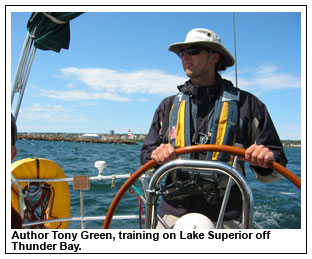 So I got busy sailing. My plan was
to log 180 days on the water over two
years. Ninety days in 2008 and 100 in
2009; pretty ambitious for the short
northern sailing season. I taught classes,
chartered and sailed on OPBs. I volunteered
for boat deliveries, traveled to
Florida in the winter, took advanced
sailing classes, signed up for group
trips and basically agreed to go anywhere
with anybody to get out on the
water. I sailed new cruising grounds,
visited new harbors, sailed after dark,
did overnight passages and met lots of
new people. And I got plenty of singlehanded
experience on my own two
boats, which was useful as an instructor
for when (not if) you have to take over
from students. The amount of new
experience and confidence I gained was
breathtaking. I often sailed in marginal
conditions that probably would have
kept me ashore if I hadn’t needed the
sea time. Few of us enjoy sailing in
snotty weather, but that’s where the real
skills are earned. Of course, there’s a
foolhardiness
but that judgment comes from
experience and education and I was
getting plenty of both. The reality is
that I am a much better sailor and
instructor for having followed the rules.
Plus, I had so much fun that I kept on
sailing even after hitting the magic
number of 360 and ended up with five
days of overkill.
So I got busy sailing. My plan was
to log 180 days on the water over two
years. Ninety days in 2008 and 100 in
2009; pretty ambitious for the short
northern sailing season. I taught classes,
chartered and sailed on OPBs. I volunteered
for boat deliveries, traveled to
Florida in the winter, took advanced
sailing classes, signed up for group
trips and basically agreed to go anywhere
with anybody to get out on the
water. I sailed new cruising grounds,
visited new harbors, sailed after dark,
did overnight passages and met lots of
new people. And I got plenty of singlehanded
experience on my own two
boats, which was useful as an instructor
for when (not if) you have to take over
from students. The amount of new
experience and confidence I gained was
breathtaking. I often sailed in marginal
conditions that probably would have
kept me ashore if I hadn’t needed the
sea time. Few of us enjoy sailing in
snotty weather, but that’s where the real
skills are earned. Of course, there’s a
foolhardiness
but that judgment comes from
experience and education and I was
getting plenty of both. The reality is
that I am a much better sailor and
instructor for having followed the rules.
Plus, I had so much fun that I kept on
sailing even after hitting the magic
number of 360 and ended up with five
days of overkill.
In the off season, I bought a study
guide and hit the books. Candidates
have to pass written tests on Rules of
the Road, General Navigation,
Charting, Deck Seamanship and Safety.
Here, my Navy experience was very
useful, as Uncle Sam had taught me a
lot of the material when I was training
for the submarine fleet. Navigation and
charting hadn’t changed much since I
learned them in the 1980s and much of
the firefighting, safety and deck seamanship
topics were also review.
Additionally, my ASA courses reinforced
some of the material, including
the Rules of the Road, which required a
passing score of 90% for all levels of
licenses. I had originally planned to
study on my own; then I learned that I
would have to travel to one of the Coast
Guard’s 17 Regional Examination
Centers (RECs) to take the tests. The
nearest RECs to my Minneapolis home
were St. Louis, Missouri and Toledo,
Ohio. The other option was to take the
exams at an authorized school and there
were a couple near the Twin Cities.
So there I was in April of 2009 listening
to Captain Ted Gephart, owner
of Superior Marine Training. There
were 15 students in the class, mostly
power boaters from Minnesota and
Wisconsin, although three of us were
sailors and one student had traveled
from Missouri. Ted plowed through the
huge volume of material in the 60-hour
class with energy and humor. Some
topics were dry and tedious, such as the
Code of Federal Regulations, while
others like marine weather were more
interesting. We covered Rules of the
Road every day until we could just
about recite the book. Hands-on
demonstrations on life rafts and rigging
blocks and tackles were useful and
there was plenty of charting practice to
break up the textbook lessons. Because
the sea time for an OUPV and Inland
Masters license were the same, I decided
to upgrade. Superior Marine offered
the Master’s course for an additional
fee and three more days of classes.
Captain Ted also incorporated the
Auxiliary Sail and Assistance Towing
material and exams into the Masters
course, so I got those endorsements too.
He even arranged for on-site drug testing
and medical exams for those that
needed them. Tuition also included
individual consultation on the application
process, supported by Ted’s
20-plus years of experience training
professional mariners.
I was slowly checking things off
my list. A new brainchild of bureaucracy
is the Department of Homeland
Security’s Transportation Worker
Identification Credential (TWIC).
Originally conceived to control access
to secure areas of commercial ports, it
is now required for all licensed merchant
mariners, including Great Lakes
sailing instructors. The TWIC is a
photo ID card with a chip containing
biometric and personal information. It’s
impressive and official-looking, but it
cost me $145 and a couple of trips to a
Roseville, Minnesota office park. I also
needed to take an oath and get it notarized.
Three letters of recommendation
were required for new applicants from
people (preferably not relatives) who
can attest to one’s character and suitability
for the duties of Captain or
Master. I’m happy to say that it wasn’t
too hard to find three friends who
thought I would make a good captain
(Thanks Julia, Brian and Thom).
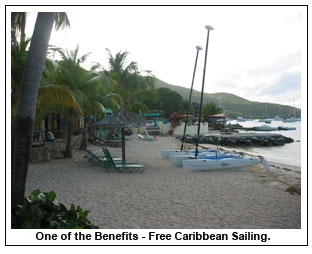 When the sailboats were hauled out
in October, it was time to assemble my
application and send it in. I applied for
a 50-ton Master’s license; I had originally
wanted a 100-ton ticket, but you
needed 90 days of service on vessels of
51 gross tons or higher or 180 days on
vessels over 33.4 tons, according to the
rules. For a 50-ton license, only one
day on a vessel larger than five tons is
required. Interestingly, a Coast Guard
ton is based on interior volume, not displacement.
When the sailboats were hauled out
in October, it was time to assemble my
application and send it in. I applied for
a 50-ton Master’s license; I had originally
wanted a 100-ton ticket, but you
needed 90 days of service on vessels of
51 gross tons or higher or 180 days on
vessels over 33.4 tons, according to the
rules. For a 50-ton license, only one
day on a vessel larger than five tons is
required. Interestingly, a Coast Guard
ton is based on interior volume, not displacement.
In late November, an envelope
came. No, it wasn’t my license, but a
polite note from the Coast Guard
National Maritime Center (NMC).
There was a problem with my application.
My drug test was seven months
old and the limit was six. Damn.
One week, $60 and another urine sample later, I faxed the
new test results (yes, they were negative) to my examiner, a
pleasant lady in West Virginia who was very helpful and
understanding. The NMC sent me regular updates via e-mail
and had a website where I could log in anytime and check the
status of my application. My phone calls got returned and I
had a very positive experience dealing with the Coast Guard.
By mid-December I had my license. It looks like a red passport,
complete with holographic images embedded in the
pages and a clear pocket in the back for my TWIC card.
The whole process cost me several thousand dollars and
many spring, summer and fall days away from my family.
Would I do it all over again? Absolutely. It opened up new
teaching opportunities previously forbidden by law, raised my
pay grade, separated me from other ASA instructors and gave
me a cool title. Sure, the designation feeds the ego, but the
real value for me was the experience gained in accumulating
the sea time I thought I already had. I am a much more confident
and capable sailor and instructor for having met all of the
requirements as written. I suppose that’s why they’re
required. Officially, I am a 50-ton Inland and Great Lakes
Master, with Auxiliary Sail and Commercial Towing
Assistance endorsements. But you can just call me Captain.
Captain Tony Green has been boating since 1985, including
eight years on U.S. Navy nuclear submarines. He is an
American Sailing Association instructor for Northern Breezes
Sailing School and sails with his wife and two daughters on
Lake Calhoun in Minneapolis, on the Mississippi River and
on Lake Superior.
TOP
|